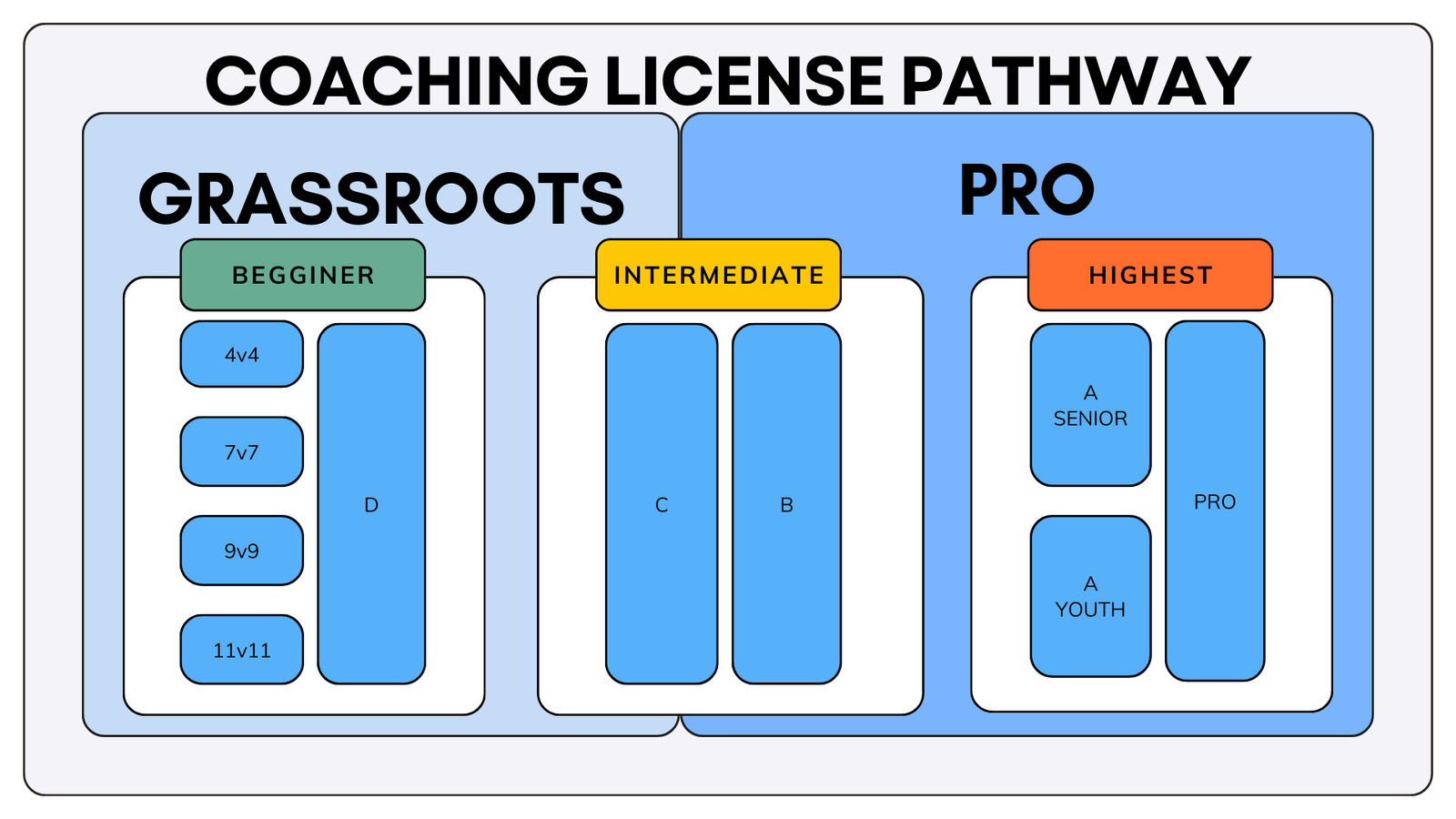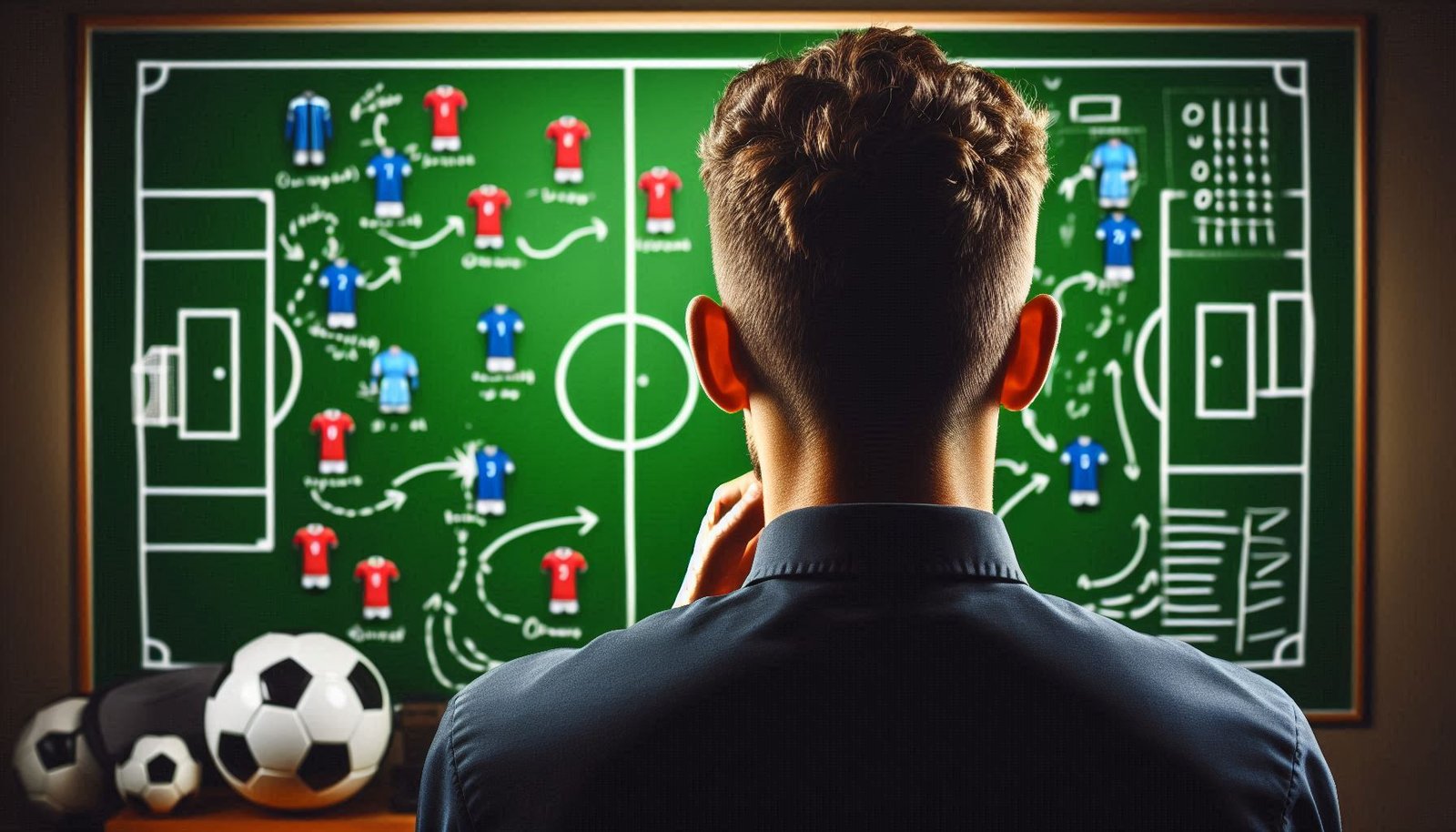Soccer Possession Drills – Tiki Taka Masterclass
Soccer Possession Drills to create a Tiki-Taka team.
We love rondos, but what is beyond that? I once had a new team that can do great rondos, but all the attacking was kick and run, or individual dribble. I had to do possession games to coach basic principles of soccer positioning and movement, not just technical skills. Here are my 3 favorite soccer possession drills for getting your team to play tiki-taka in a few short years. Stay tuned until the end where I discuss the tips on how to adjust any of these drills on the spot for maximum effectiveness.
7v4 Overloading Soccer Possession Drills
The basic drill is to have a 7v4 setup where the only goal is to keep possession. The attacking team should connect 20 passes to win, while the defending team needs to get the ball and have 5 passes for victory. If either team succeeds in their goal, then the other team does pushups. Often times the ball will go out of bounds, so give around 10 attempts for the team do accomplish the goal. After that rotate the players between offense and defense, so that everybody experiences playing both roles and nobody gets too frustrated by being outnumbered all the time.
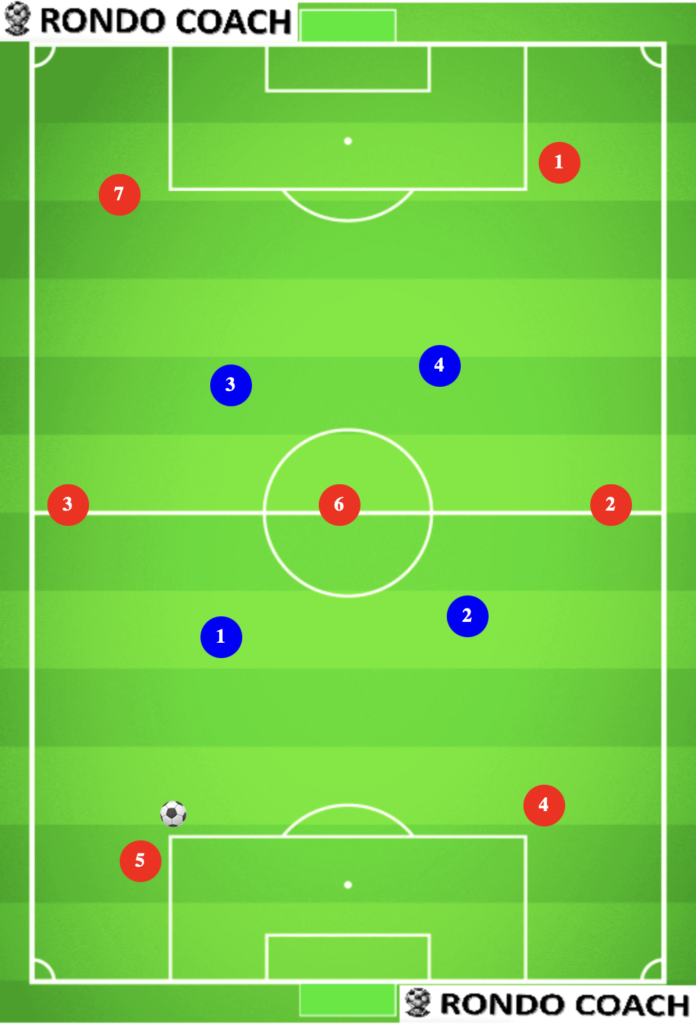
If you need change the intensity because the defenders keep winning or the attackers keep winning, consider changing the number of players or modifying the field size. For example, instead of 7v4 you can change to 7v3 or 7v5. Similarly, if everything looks good but the players seem to have too much time, shrink the field a bit.
Coaching points for the attacking team
The coaching point for the attacking team is back to first principles of soccer. You want more space and time on the ball when your team is in possession. For that, you want to make the playing area as large as possible and that is defined by the distance between the players. The coaching points will be for players to stay wide and far from their opponents, then use the center of the field as helping functions to move the ball again to the edges of the playing area. However, the players on the periphery must open up or make a third-man runs so that either direct passes can get to them or at least one-touch passes from the central players can find them.
Coaching points for the defending team
The defenders will get the inverse coaching points. They want to make the playing area as small as possible, so they would want to limit the passing options and try to convert the playing area from full field of 7v4 to maybe half the field and playing 4v4. Forcing the attacking team to do extra touches on the ball, slow down the ball movement and narrow down the passing options is the key in accomplishing their goal.
2 Endzones Possession Drills
The two endzones game is simple and structured. Overall, we play something like 7v5, but we create some resemblance of a formation. We create two endzones on the opposite side of the field, where we put two attackers and one defender, and we restrict their movement only to that area. The attacking team need to move the ball from one endzone to the other while retaining possession. If they manage to do that, then the defending team does pushups. You should give them 10 tries and if they fail to do that, then they do pushups.
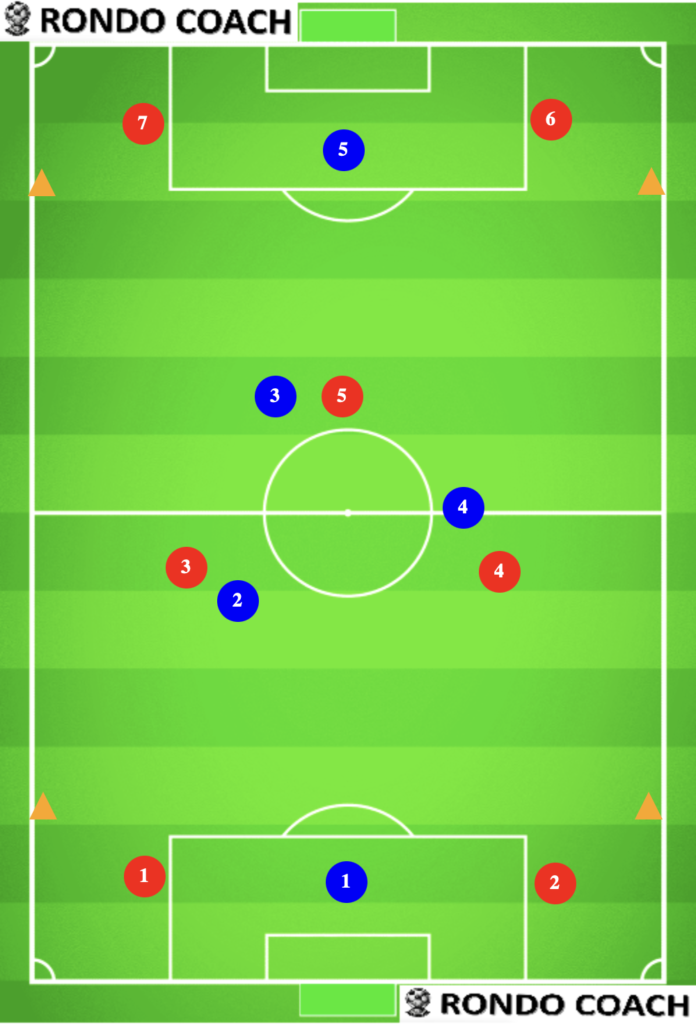
It’s a natural evolution of the previous soccer possession drills where your players keep the ball at 7v3 or 7v4. However, we give the players direction and intention in this drill. Both teams know which direction the game is going. If they struggle to keep any structure in the previous drill, then it is ok to start with this drill, but maybe keep 3v2 in the middle if the attacking team fails to keep possession. If the attacking team feels too comfortable at 7v5, then allow the defending team to move anywhere. It will increase the intensity significantly.
Coaching points for the attacking team
The attacking team will get coaching points about space and options. They need to understand that if the space is tight where the ball is, that means that somewhere else there is more space. For example, in the middle of the field, it’s almost always hard to get time on the ball. There we are playing 3v3, but together with the endzone becomes 5v4. However, we already told the players that the endzone is always a safe space for them to pass back to, so they should use that. Sometimes they will delay the pass out of the endzone, creating La Pausa.
Coaching points for the defending team
The coaching points for the defense is that this time they are defending a goal, not just possession. Their aim is to prevent the opponent from achieving their goal. We have given them the direction of how the opponent will attack, so the defense should actually recreate the playing area to make it much smaller and make the game 5v4 on half the field or less instead of 7v5 on full field. They should even position themselves on the same side of the players, so that it is harder for player 7 to receive a pass the playing area ends up being 4v4. In the video we saw that even after the attacking team occupied one of the endzones, the defending team kept playing high press and chasing the defenders, which was a mistake. Only when a bad touch or intense pressure is created, they should press to obtain the ball. In the meantime, they should develop a bit more comfort of being patient but still work hard while not in possession.
Striker pressing coaching point
One more quick coaching point, specifically for the defender in the endzone. The simplest help we can give them is to tell them to cut the pass to the other defender. If they do that and increase pressure, then effectively they have converted 2v1 into a 1v1 and have pinned down the player into a tight area. The player in possession will have restricted movement from 3 sides by out lines, so it’s the prefect setup for the defender to press, but only if they block the pass to the other attacker. This will help them understand how high press should work which is to limit the options for passing, then put pressure on the player. When most of the time the defenders play with numerical disadvantage, creating 1v1 in a tight space is worth a lot.
4 Endzones Soccer Possession Drills
Possession with 4 endzones. We set a 7v7 game, roughly at half of the field. We carve out areas at all 4 edges to be endzones and the goal is to retain possession while moving them from one endzone to the other. If all 4 endzones have been occupied, then we have a winner. If possession is lost, then the other team tries to do the same. This is my favorite drill because it is continuous, equal for both teams and it naturally increases intensity by shrinking the playing area which makes players think about their intention, individually and as a team. Note that there is no real attacking vs. defending team assigned before the game, because the possession keeps switching, same as a real soccer game.
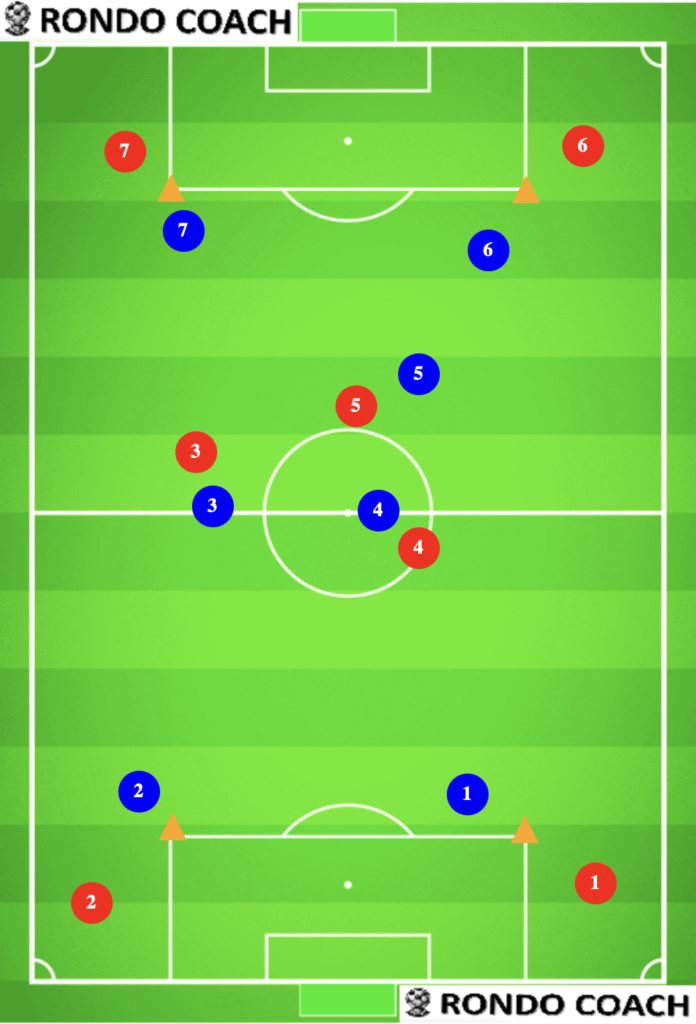
Note that the game looks the same in theory, but it totally changes as the endzones are visited. At the beginning it is a high press game where the only goal for defenders is to recover possession for their team. Then, once the team has conquered one of the zones, the defenders don’t need to guard that zone and the playing area should shrink. Usually, the attacking team is able to occupy the adjacent endzones and then the game looks a lot like soccer where the goal is the direction is clear to get to the other endzone. The risk for the attackers to lose the ball is large at that point because if they do, they will need to start all over again by firstly winning the ball and then with no occupied endzones. The risk for the defenders is that if they don’t defend the endzone, they will simply lose.
Coaching points for the attacking team
Attackers, you have to figure out the game you are playing, is it intention or ball retention? When you are under pressure, it is often just ball retention. When you are off the ball, then it’s about intention and figuring out where the free teammate is and how you can position yourself to receive the ball and progress it to your teammate. Once you are missing only one endzone, if you can quickly attack it, then it will make it easier for you. If you attack slowly and allow all opponents to come back to the zone, it will make it much harder.
Coaching points for the defending team
Defenders, you must understand the context of the soccer possession drills as a team. If you keep pressing while your team doesn’t, then you will get tired. Similarly, if your team is pressing and you are the only one that is not, then you are letting them down as if the other team plays with an extra player. However, if you are defending with only one zone left, you need to change your mindset and show some patience. Defending as a team means that everybody on the team has the same intention and their movement reflects that. Coming back late to help your team means that you allow the opponents multiple opportunities, not just one.
Tips, Tricks and Advice for Successful Soccer Possession Drills
I intertwined some advice, but let’s lay them all out here. The hardest thing in these drills is to figure out how to get the right level of intensity. Too much intensity and players might give up, but at too little they are either goofing off or simply not giving full effort. You want the success rate of the drill objective, for example 20 passes, to be at around 50%. That means that if they have 10 tries, they will be able to complete 20 passes half of that time. The other times they might be able to complete around 10 passes. You shouldn’t fix this by increasing the number of tries, but the difficulty of each try. Let’s talk about size of the field, players on the teams, player groupings, restrictions we can put, and the incentives to win.
Field size, number of players, types of players and restrictions
The size of the field and the number of players are things you can fix on the spot. Very often the endzones are too large or too little. You should just fix them on the spot, don’t even tell the players and just move the cones to do that. They will figure it out.
The number of players can be a bit trickier. For example, you have designed the drill for 7v4, but you have 12 players at practice, so you have an extra player. Do you make them sit on the side and wait? Or you make it 7v5 or 8v4? Or you make it 8v5 with you jumping in on the other team? All of these are valid solutions, but you need to figure out what works best in the moment.
Another interesting one is the types of players that randomly grouped. For example, the top 4 players started playing on defense in a 7v4 setup and you think you hit the right level of difficulty. Then you rotate the players and all of a sudden you get the wrong balance and success rate. Instead, you pick the players on defense and plan for a balanced teams with similar work rate.
One more tweak I would suggest is to limit the number of touches. This is a common one to increase the speed of play. I sometimes give the players in middle, between the endzones, only two touches. After few times they practice the drill I don’t have to give them this restriction because they figure out that the two touches limit is what they need to do to improve their effectiveness most of the time.
Likely you will need to combine all of these to get to the magical target of around 50% success rate. Don’t be scared to improvise and adjust all the time. However, you need to plan for it by balancing the teams, size and players.
The power of incentives
Finally, the incentives are the least technical, but can be the most effective knob to turn. Some players just want to win every single time in every single thing against every single opponent. If you have players like that, then consider yourself lucky. Society forces people to not want that, and that’s the only way we can have civil society. However, soccer is a competitive game and we need to switch the brain of the players to want to win at everything within the rules of the game the moment they step on the field. You need to see what motivates the players. I often let my players play on one big goal vs two small goals. Everybody wants to play on the big goal, so the rule is that if the team playing on the small goals score, they switch. That motivates both teams, one to attack the best they can, the other team to defend at their maximum. In the soccer possession drills, we said that the losing team does pushups. I’ve sometimes let the players choose the prize and that has worked out great because I learn what motivates them. There was one time that we did a drill where the two winners got to make the teams for scrimmage, simple and easy way for me to give authority to the players.

